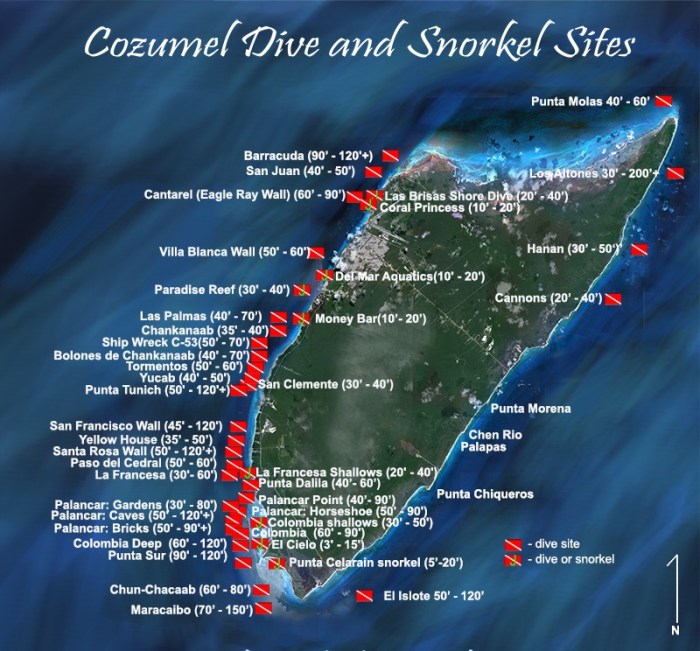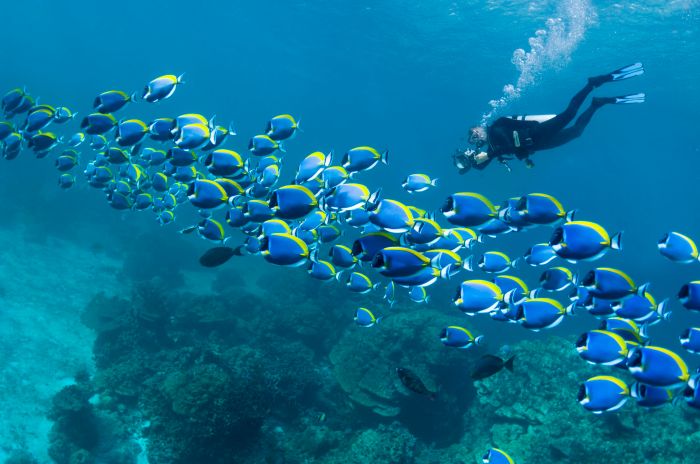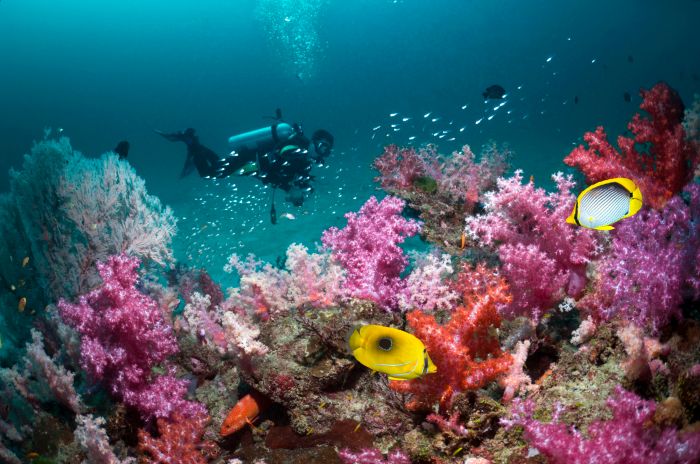Embark on an extraordinary underwater adventure as we unveil the captivating world of scuba diving locations. Dive into the depths of marine ecosystems, where vibrant coral reefs, majestic marine life, and breathtaking underwater landscapes await your exploration. From the azure waters of the Caribbean to the enigmatic depths of the Pacific, discover the top scuba diving destinations that will leave you spellbound.
Whether you’re a seasoned diver seeking new frontiers or a novice eager to experience the wonders of the underwater world, this comprehensive guide will equip you with everything you need to know about choosing the perfect scuba diving location, planning an unforgettable trip, and ensuring your safety while immersing yourself in the beauty of the ocean.
Introduction

Scuba diving has emerged as an increasingly popular recreational activity, captivating individuals worldwide with its allure of underwater exploration and discovery. The captivating beauty of the underwater world, teeming with diverse marine life and enigmatic ecosystems, beckons adventure enthusiasts to immerse themselves in its depths.
When it comes to scuba diving locations, the Caribbean is a top destination. With its crystal-clear waters, vibrant coral reefs, and diverse marine life, it’s no wonder that divers from around the world flock to this region. But beyond its underwater wonders, the Caribbean also boasts some of the best beaches in the world.
From the white-sand shores of Jamaica to the turquoise waters of the Bahamas, there’s a beach for every taste. For a comprehensive guide to the best beaches in the Caribbean, check out this helpful article: best beaches in the Caribbean.
And when you’re ready to explore the underwater world, be sure to check out the many scuba diving operators throughout the region.
Statistics paint a compelling picture of the growing enthusiasm for scuba diving. In 2023, an estimated 10 million individuals worldwide actively participated in scuba diving, representing a significant increase from previous years. This surge in popularity can be attributed to factors such as increased awareness of marine conservation, advancements in scuba diving equipment, and a growing desire for unique and immersive travel experiences.
Types of Scuba Diving Experiences
The realm of scuba diving offers a diverse range of experiences, catering to the interests and skill levels of all enthusiasts. From leisurely dives amidst vibrant coral reefs to adrenaline-pumping explorations of underwater caves and wrecks, there’s an adventure to suit every taste.
The world’s oceans offer a vast array of scuba diving locations, each with its unique underwater treasures. Whether you’re a seasoned diver or a beginner looking to explore the wonders of the deep, there’s a destination out there for you.
From the vibrant coral reefs of the Caribbean to the mysterious shipwrecks of the Pacific, the possibilities are endless. To discover the best scuba diving locations around the globe, check out our comprehensive guide scuba diving locations. With detailed descriptions and insider tips, you’ll be able to plan the perfect underwater adventure.
- Recreational Diving: The most common form of scuba diving, recreational diving involves exploring underwater environments for leisure and enjoyment. This type of diving typically takes place in relatively shallow waters and is suitable for beginners and experienced divers alike.
- Technical Diving: Geared towards experienced divers, technical diving involves exploring deeper waters and more challenging environments, often requiring specialized equipment and training. Technical divers may encounter underwater caves, wrecks, or deep reefs, demanding advanced skills and knowledge.
- Scientific Diving: As the name suggests, scientific diving is conducted for research and exploration purposes. Scientists and researchers utilize scuba diving techniques to study marine ecosystems, conduct underwater surveys, and collect data for conservation efforts.
Top Scuba Diving Destinations
The world’s oceans are teeming with incredible underwater life, and there are countless amazing places to scuba dive. From vibrant coral reefs to ancient shipwrecks, there’s something for everyone to enjoy. Here’s a list of the top 10 scuba diving destinations worldwide, each offering unique experiences and unforgettable adventures:
Destination Highlights
| Destination | Region | Highlights | Image |
|---|---|---|---|
| Great Barrier Reef, Australia | Coral Sea | The largest coral reef system in the world, home to over 1,500 species of fish and 400 types of coral. | [Image of the Great Barrier Reef with colorful coral and fish] |
| Raja Ampat, Indonesia | West Papua | Known for its stunning coral gardens, abundant marine life, and diverse underwater topography. | [Image of a diver exploring a coral reef in Raja Ampat] |
| Galapagos Islands, Ecuador | Pacific Ocean | A UNESCO World Heritage Site, famous for its unique wildlife, including sea lions, penguins, and marine iguanas. | [Image of a diver swimming with sea lions in the Galapagos Islands] |
| Cozumel, Mexico | Caribbean Sea | Boasts the second-largest barrier reef in the world, with excellent visibility and a wide variety of marine life. | [Image of a diver exploring a coral reef in Cozumel] |
| Maldives | Indian Ocean | An archipelago of over 1,000 islands, known for its crystal-clear waters, white-sand beaches, and luxurious resorts. | [Image of a diver swimming in the clear waters of the Maldives] |
| Palau | Micronesia | Home to the famous Jellyfish Lake, where millions of non-stinging jellyfish create an unforgettable experience. | [Image of a diver swimming with jellyfish in Jellyfish Lake] |
| Bonaire, Netherlands Antilles | Caribbean Sea | A diver’s paradise with over 80 dive sites, offering pristine reefs, wrecks, and abundant marine life. | [Image of a diver exploring a wreck in Bonaire] |
| Komodo National Park, Indonesia | Lesser Sunda Islands | Known for its incredible biodiversity, including the Komodo dragon, manta rays, and sharks. | [Image of a diver swimming with manta rays in Komodo National Park] |
| Sipadan Island, Malaysia | Celebes Sea | A small island with some of the richest marine life in the world, including barracuda, sharks, and turtles. | [Image of a diver exploring a coral reef in Sipadan Island] |
| Sharm el-Sheikh, Egypt | Red Sea | Offers stunning coral reefs, shipwrecks, and the opportunity to dive with dolphins and sharks. | [Image of a diver exploring a coral reef in Sharm el-Sheikh] |
Choosing a Scuba Diving Location

Selecting the perfect scuba diving location is crucial for an enjoyable and memorable experience. Here are key factors to consider when making your choice:
Experience Level
Choose a dive site that aligns with your skill and comfort level. Beginner divers should opt for shallow, calm waters with good visibility, while experienced divers can explore more challenging sites with deeper depths and stronger currents.
Dive Site Conditions
Research the specific dive site conditions, including visibility, water temperature, and depth. Consider the time of year and weather patterns to ensure optimal conditions for your dive.
Marine Life Diversity
Identify your interests in marine life. Different dive sites offer unique opportunities to encounter specific species. Research the area’s biodiversity to choose a site that caters to your interests, whether it’s colorful coral reefs, majestic sea turtles, or elusive sharks.
Accessibility and Cost
Consider the accessibility of the dive site, including travel time, availability of dive operators, and overall cost. Factor in expenses such as accommodation, dive gear rental, and boat fees to determine if the location fits your budget.
Planning a Scuba Diving Trip

Planning a scuba diving trip requires careful preparation and consideration to ensure a safe and enjoyable experience. Here’s a step-by-step guide to help you plan your trip:
Booking Flights and Accommodation
* Determine your destination and travel dates.
* Research and compare different airlines and book flights that align with your budget and schedule.
* Book accommodation that meets your needs, whether it’s a resort, guesthouse, or liveaboard.
Choosing a Dive Operator
* Check online reviews and testimonials to find reputable dive operators.
* Consider their experience, safety record, and dive site selection.
* Inquire about their equipment rental options and guided tours.
Packing the Necessary Gear
* Gather essential scuba diving gear, including a wetsuit or drysuit, fins, mask, snorkel, regulator, and buoyancy compensator device (BCD).
* Pack appropriate clothing and toiletries for the destination and weather conditions.
* Protect your gear by using waterproof bags and hard cases.
Obtaining Necessary Certifications
* Ensure you have the required scuba diving certification for the planned dives.
* If necessary, complete the appropriate training courses and obtain the required certification before your trip.
Safety Considerations for Scuba Diving

Scuba diving is an exhilarating activity that allows us to explore the underwater world, but it’s crucial to prioritize safety to ensure an enjoyable and risk-free experience. Understanding common risks and adhering to safety guidelines is essential for responsible diving practices.
Exploring the breathtaking underwater world through scuba diving is an experience like no other. To ensure the preservation of these marine ecosystems, consider implementing eco-friendly travel tips during your diving adventures. From using biodegradable sunscreen to minimizing plastic waste, every effort counts in safeguarding the delicate balance of scuba diving locations for future generations.
Common Risks and Hazards
Before embarking on a dive, it’s essential to be aware of potential hazards and risks, including:
- Decompression sickness: Occurs when nitrogen bubbles form in the body due to rapid ascent, causing joint pain, fatigue, and even paralysis.
- Oxygen toxicity: Breathing pure oxygen at depths greater than 20 meters can lead to seizures and other neurological problems.
- Nitrogen narcosis: The intoxicating effect of nitrogen at depths greater than 30 meters, impairing judgment and coordination.
- Drowning: While rare, drowning can occur due to equipment failure, panic, or exhaustion.
Safe Diving Practices
To mitigate risks and ensure a safe diving experience, follow these guidelines:
- Proper training and certification: Obtain certification from a reputable diving organization to gain essential knowledge and skills.
- Dive with a buddy: Never dive alone; having a companion increases safety and provides assistance in emergencies.
- Check equipment: Inspect your diving gear thoroughly before each dive, ensuring it’s in good working order.
- Plan your dive: Familiarize yourself with the dive site, including depth, currents, and potential hazards.
- Respect your limits: Dive within your capabilities and avoid exceeding recommended depths or durations.
- Ascend slowly: Follow proper ascent rates to prevent decompression sickness.
- Stay hydrated: Dehydration can impair judgment and increase the risk of decompression sickness.
- Listen to your body: If you experience any discomfort or symptoms, abort the dive and seek medical attention.
Environmental Impact of Scuba Diving: Scuba Diving Locations
Scuba diving, while an exhilarating and rewarding activity, has the potential to impact marine ecosystems if not conducted responsibly. Divers can contribute to minimizing their environmental footprint by adhering to sustainable practices.
Understanding the impact of scuba diving on marine life is crucial. Divers can inadvertently damage coral reefs, disturb marine animals, and contribute to pollution through improper buoyancy control, careless finning, and littering. However, by following sustainable diving practices, divers can enjoy the underwater world while preserving its delicate balance.
Minimizing Environmental Impact, Scuba diving locations
To minimize their impact on marine ecosystems, divers should:
– Maintain neutral buoyancy to avoid damaging coral reefs and other fragile marine life.
– Use proper finning techniques to prevent disturbing sediment and damaging seagrass beds.
– Avoid touching or harassing marine animals, as this can cause stress and disrupt their behavior.
– Dispose of waste responsibly by carrying a mesh bag for trash and avoiding leaving behind any debris.
– Choose dive operators that prioritize environmental conservation and follow sustainable practices.
Sustainable Diving Practices
Examples of sustainable diving practices include:
– Using biodegradable sunscreen to protect against harmful UV rays without polluting the water.
– Supporting marine conservation organizations and initiatives to protect and restore marine ecosystems.
– Participating in underwater cleanups to remove debris and reduce pollution.
– Choosing dive sites that are managed sustainably and have measures in place to protect marine life.
By adopting these sustainable practices, divers can help preserve the health and beauty of the underwater world for generations to come.
Last Word

As you plan your next scuba diving adventure, remember that every dive is an opportunity to connect with the wonders of the underwater world and create memories that will last a lifetime. Embrace the responsibility of being an ocean ambassador, minimizing your environmental impact and promoting sustainable diving practices. Dive with purpose, explore with passion, and let the allure of scuba diving locations captivate your soul.
FAQ Insights
What are the key factors to consider when choosing a scuba diving location?
Experience level, dive site conditions, marine life diversity, accessibility, and cost.
How can I minimize my environmental impact while scuba diving?
Use biodegradable sunscreen, avoid touching marine life, and choose dive operators committed to sustainable practices.
What are some of the most popular scuba diving destinations worldwide?
The Great Barrier Reef, the Maldives, the Galapagos Islands, the Red Sea, and the Caribbean Sea.